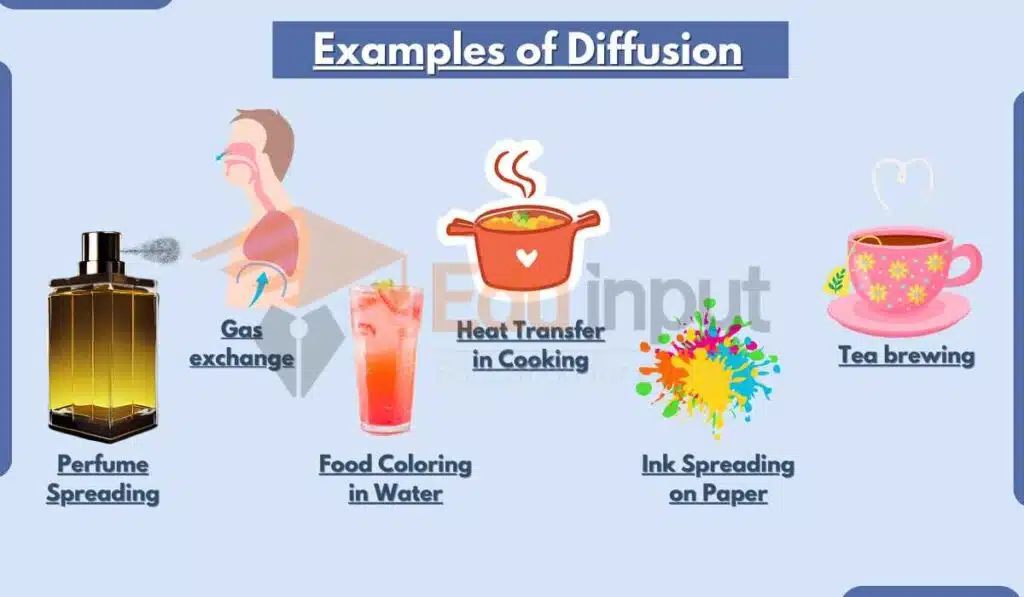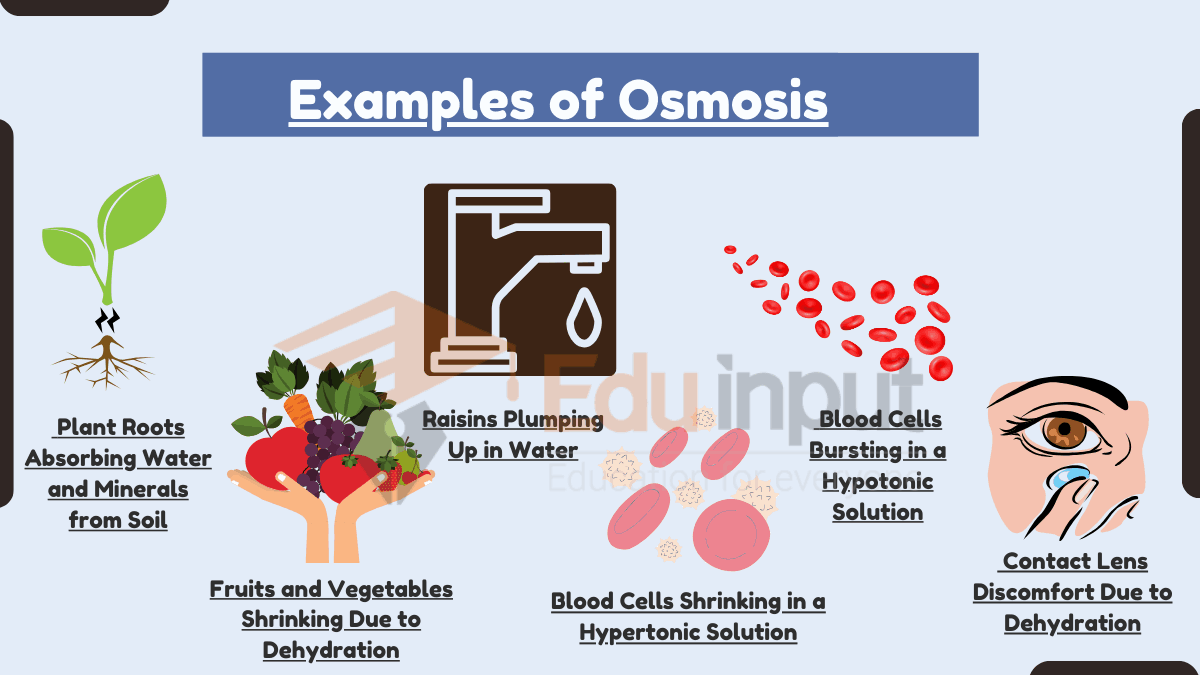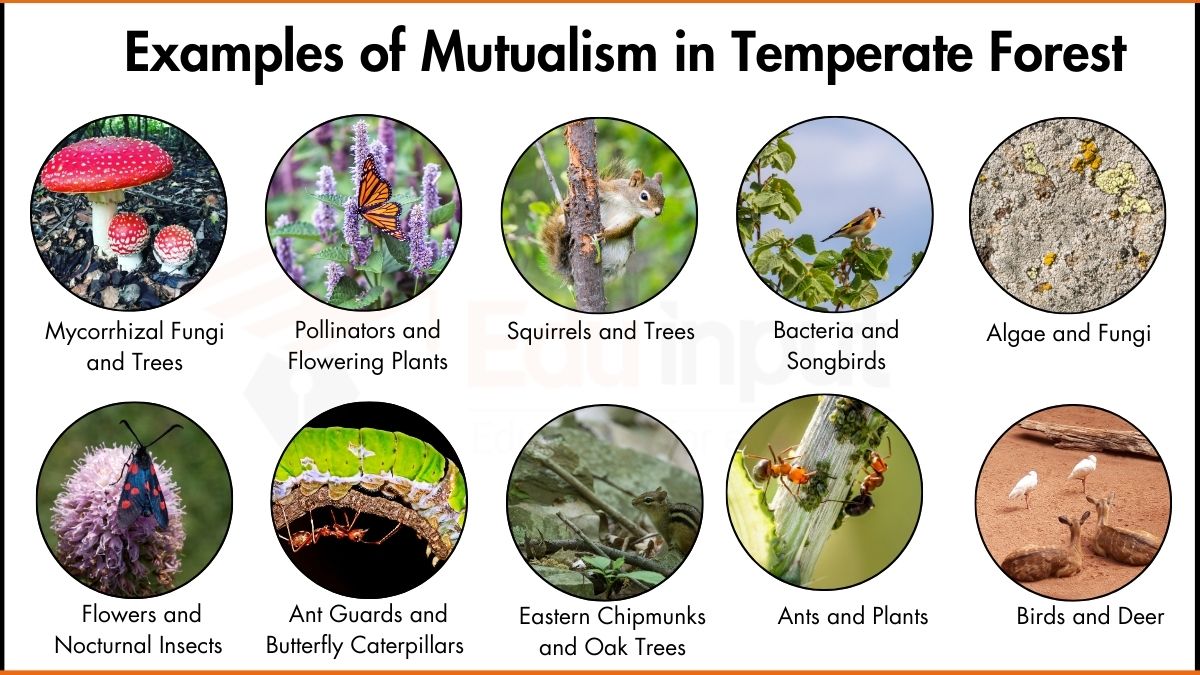20+ Diffusion Examples in Biology and Daily Life
Ever smelled fresh bread baking or perfume spreading through a room? That’s diffusion, molecules moving from high to low concentration. It plays a vital role in everyday life, from breathing and cooking to pollution and disease spread. In this article, we will explore 20+ real-life diffusion examples across biology, household activities, and the environment to see how this invisible process shapes your world.
Gas Exchange in the Lungs, Perfume Spreading, Food Coloring in Water, Heat Transfer in Cooking, and Scent of a freshly cut lawn are a few examples of diffusion.

Everyday Diffusion Examples
| Category | Example | Diffusion Process |
| Biological Systems | Gas Exchange in Lungs | Oxygen diffuses to blood, CO₂ diffuses to alveoli |
| Nutrient Diffusion in Cells | Glucose and oxygen diffuse into cells for energy | |
| Medication Absorption | Drug molecules diffuse into bloodstream through digestive lining | |
| Scent Diffusion in Flowers | Volatile compounds diffuse to attract pollinators | |
| Oxygen in Water | Oxygen diffuses into water for aquatic life | |
| Plant Transpiration | Water vapor diffuses from leaves into the air | |
| Household/Culinary | Perfume Spreading | Scent molecules diffuse through air |
| Food Coloring in Water | Dye molecules diffuse to create even color | |
| Sugar Dissolving in Coffee | Sugar molecules diffuse to sweeten evenly | |
| Tea Brewing | Flavor compounds diffuse into hot water | |
| Aroma of Baking Bread | Volatile scents diffuse through air | |
| Flavor of Food | Flavor molecules diffuse in saliva, activating taste receptors | |
| Ink Spreading on Paper | Ink molecules diffuse into paper fibers | |
| Air Fresheners | Fragrance molecules diffuse through the air | |
| Heat Transfer in Cooking | Heat diffuses from source to cook food evenly | |
| Environmental/Social | Scent of Freshly Cut Lawn | Grass VOCs diffuse through air |
| Smoke from a Cigarette | Smoke particles diffuse into surrounding air | |
| Air Pollution | Pollutants diffuse from source across environment | |
| Disease Spread via Air | Pathogen-containing droplets diffuse to nearby people | |
| Fragrance from a Candle | Scent molecules diffuse into room air | |
| Ocean Salinity Mixing | Salt ions diffuse to balance salinity across regions | |
| Compost Odors | Gases from decomposing material diffuse into the air |
Diffusion Examples in Biological Systems
Diffusion in biology means the movement of tiny particles like gases or nutrients from a place where there is more of them to a place where there is less. This process helps living things survive. It happens in our bodies, in animals, and plants.
Below are some easy-to-understand examples of how diffusion works in biology.
1. Gas Exchange in the Lungs
When you breathe in, oxygen enters your lungs. Inside your lungs are small air sacs called alveoli. These sacs are surrounded by tiny blood vessels. Oxygen moves, or diffuses, from the alveoli into your blood because there is more oxygen in the lungs than in the blood. At the same time, carbon dioxide, which your body doesn’t need, moves from the blood into the lungs and is breathed out. This is a clear example of how diffusion helps you breathe and stay alive.
2. Nutrients Diffusing into Cells
Your body needs energy to do everything. That energy comes from nutrients like glucose and oxygen. These nutrients are in your blood. Because the concentration of glucose and oxygen is higher in the blood than in your cells, they diffuse into the cells. Once inside, the nutrients help the cells produce energy. Without diffusion, your cells wouldn’t get the fuel they need to work.
3. Medication Absorption
When you swallow a tablet or take medicine, the drug moves to your stomach or intestines. From there, the medicine particles diffuse into your blood. Once in your bloodstream, the medicine can reach different parts of your body to do its job. For example, aspirin diffuses into your blood to help stop pain. This is another example of diffusion in biology that we experience every day.
4. Scent Diffusion in Flowers
Flowers release pleasant smells into the air. These smells come from tiny scent molecules. The molecules spread out or diffuse into the air. Bees and butterflies can detect these smells and follow them to the flowers. This helps insects find nectar and helps flowers get pollinated. In this way, diffusion helps plants survive and reproduce.
5. Oxygen in Water for Aquatic Life
Fish and other water animals need oxygen to live. But they don’t breathe air like humans. Instead, they get oxygen from the water. Oxygen from the air slowly diffuses into lakes, rivers, and oceans. Fish use their gills to absorb this oxygen. Diffusion allows aquatic animals to get the oxygen they need to survive.
6. Transpiration in Plants
Plants also use diffusion when they give off water vapor through their leaves. This process is called transpiration. Water travels from the roots to the leaves. Then, some of it turns into vapor and diffuses into the air. This movement of water vapor helps the plant take in more water and nutrients from the soil. It’s a simple but important example of diffusion in plants.
Diffusion Examples in Household
Diffusion doesn’t just happen in science labs or inside the body—it happens all around us at home, especially when we cook, clean, or enjoy smells. This type of diffusion shows how particles move from places with more of them to places with fewer, creating changes we can see, smell, or taste. Here are some easy examples of diffusion you probably experience every day.
7. Perfume Spreading in a Room
When someone sprays perfume, you can smell it even if you’re far away. That’s because tiny scent particles leave the bottle at a high concentration and spread into the air where there are fewer scent particles. This is how diffusion works in gases. It shows how quickly molecules move and spread out, filling the whole room with a nice smell. This is a great real-life diffusion example.
8. Food Coloring in Water
When you drop food coloring into a glass of water, you see the color slowly spread. At first, the dye stays in one spot, but soon it begins to mix with the water, even without stirring. That’s diffusion. The dye molecules move from the crowded spot into the rest of the water where there’s less of them. This is a simple way to see diffusion in liquids.
9. Sugar Dissolving in Coffee
Imagine adding sugar to a hot cup of coffee. The sugar crystals slowly disappear and spread throughout the drink. That’s because sugar molecules move from where there are a lot (the sugar pile) to where there are fewer (the coffee). This is another example of how diffusion works, helping to sweeten your drink evenly.
10. Tea Brewing in Hot Water
When you put a tea bag into hot water, the flavor and smell spread throughout the cup. This happens because the tiny flavor particles inside the tea leaves move out into the water. The heat helps them move faster. This is called diffusion in cooking and it’s the reason your tea tastes the same with every sip.
11. Aroma of Baking Bread
Have you ever smelled bread baking in the oven and noticed how the scent fills your kitchen? That’s diffusion. The smell comes from tiny scent particles in the bread that rise into the air and spread around the room. This warm, delicious scent is carried by air through diffusion.
12. Flavor of Food in Your Mouth
When you eat, the flavor from your food spreads across your tongue. Tiny molecules in the food dissolve in your saliva and move to your taste buds. This is how you can taste sweet, salty, or spicy flavors. This type of diffusion in cooking is very important because it helps us enjoy our food.
13. Ink Spreading on Paper
When you write with a pen, the ink touches the paper and spreads into it. This happens because the paper has small holes and spaces. The ink molecules move into those spaces through diffusion. This helps the writing stay on the paper and not rub off.
14. Air Fresheners in a Room
Just like perfume, air fresheners work by releasing scent molecules into the air. These molecules spread from the freshener into the rest of the room. Over time, the smell reaches every corner of the space. This is another example of how diffusion in everyday life makes things feel fresh and clean.
15. Heat Transfer in Cooking
Diffusion doesn’t only happen with smells or colors—it happens with heat too. When you cook something on a stove, heat moves from the hot pan to the food. This heat spreads from areas of higher temperature to cooler areas. That’s thermal diffusion, and it’s what cooks your food evenly from the outside to the inside.
Diffusion Examples in Environment
Diffusion plays a key role in how substances move through our environment. Whether it’s the way pollutants spread through the air, the scent of a garden, or how diseases travel between people, diffusion is a fundamental process. This section explores real-life diffusion examples outside the home and within broader social or natural environments, helping us better understand topics in public health, ecology, and even gardening.
16. Scent of a Freshly Cut Lawn
One of the most familiar smells of summer is the scent of freshly cut grass. This pleasant aroma comes from volatile organic compounds (VOCs) released by the damaged plant cells. Once released, these scent molecules move from the area of high concentration near the lawn into the surrounding air, a perfect example of how diffusion works. This environmental diffusion not only creates a nostalgic sensory experience but also plays a role in plant signaling.
17. Smoke from a Cigarette
Cigarette smoke is a clear example of harmful diffusion. When someone smokes, toxic particles and gases are released into the air. These substances then diffuse outward, moving from the high-concentration area near the smoker to the surrounding space. This process affects nearby people through secondhand smoke exposure, making this a public health concern. It demonstrates diffusion in everyday life with serious health consequences.
18. Air Pollution from Industrial Sources
Factories and vehicles release various pollutants into the atmosphere. These substances—such as carbon monoxide, sulfur dioxide, or particulate matter—do not stay in one place. Instead, they spread out, or diffuse, into the air, sometimes traveling far from their original source. This environmental diffusion reduces air quality, even in places far from industrial areas. It’s a major reason air pollution is a global concern, not just a local one.
19. Disease Spread through the Air
When someone coughs, sneezes, or even talks, tiny droplets containing bacteria or viruses can be released into the air. These droplets diffuse into the surrounding air, potentially reaching people nearby. This type of diffusion explains how illnesses like the flu, COVID-19, and the common cold can spread quickly, especially in crowded places. Understanding this process is essential in public health, especially when managing contagious diseases.
20. Fragrance from a Candle
A scented candle creates a cozy environment, but what you’re experiencing is diffusion at work. As the candle burns, heat causes the wax to release fragrance molecules into the air. These molecules move from the candle (high concentration) to the rest of the room (low concentration), gradually filling the space with aroma. This everyday example shows how environmental diffusion contributes to comfort and mood.
21. Salt Mixing in Ocean Water
Diffusion also plays a key role in ocean chemistry. Salt ions in seawater naturally move from areas where they are more concentrated to regions where their concentration is lower. This process helps balance salinity levels across vast bodies of water. Such diffusion in nature is crucial for maintaining stable conditions for marine life, preventing abrupt changes that could affect ecosystems.
22. Compost Odors in Gardening
If you’ve ever stood near a compost pile, you’ve probably noticed a distinct smell. That odor results from the diffusion of gases produced by decomposing organic material. As bacteria break down food scraps and garden waste, they release molecules like methane or ammonia. These molecules then diffuse into the air, making the compost pile’s activity noticeable even from a distance. This is another great real-life diffusion example from gardening and waste management.





Leave a Reply